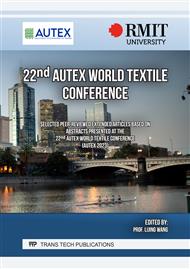p.87
p.97
p.107
p.119
p.125
p.137
p.143
p.149
p.155
Intelligent Identification of Chinese and Australian Merino Wool Fibers Based on Image Recognition
Abstract:
In order to promote the sustainable growth of the wool industry and protect consumers' legitimate rights, rapid identification of the country of origin for wool of the same type is deemed crucial. This research presents a computer graphic recognition training model that utilizes median and Wiener filtering techniques to effectively reduce noise in the raw wool fiber images. Employing a support vector machine as the classifier and integrating a polynomial kernel function, this model achieves swift and accurate identification of Chinese and Australian Merino wool fibers. Experimental results underscore that following image recognition training, the model attains an impressive 92.5% comprehensive and precise identification rate for Chinese and Australian Merino wool fibers, effectively distinguishing the origin of wool from the same category. This approach not only provides a valuable reference for identifying the origin of similar wool types but also holds the potential to standardizing the wool fibre material market and assuring the consumer’s confidence on wool products.
Info:
Periodical:
Pages:
143-148
Citation:
Online since:
March 2024
Authors:
Price:
Сopyright:
© 2024 Trans Tech Publications Ltd. All Rights Reserved
Share:
Citation:



